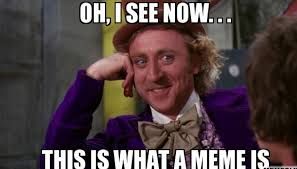MEME of the day

MEME OF THE DAY ENGLISH / SPANISH
What memes truely are 🌿
A meme is a recognizable cultural element, reproduced and transmitted by the imitation of the behavior of an individual by other people. The Oxford English Dictionary defines the "meme" as "an element of a culture (taken here in the sense of civilization) which can be considered as transmitted by non-genetic means, in particular by imitation"4.
The English term "meme" was first proposed by Richard Dawkins in The Selfish Gene (1976) and comes from an association between the English term "gene" (gene) and the Greek word "mimesis" (imitation). Dawkins also constructs this term for its resemblance to the French word "even" (although the latter has a different etymology). Memes were presented by Dawkins as replicators, comparable in this respect to genes, responsible for the evolution of certain animal behaviors and cultures.

The study of memes has given rise to a new discipline: memetics.🌿
The crypto world has applied its principles .
The meme is "a recognizable element of language transmitted by repetition from one individual to others". The definition given by Richard Dawkins corresponds to a “unit of information contained in a brain, exchangeable within a society”. It results from a hypothesis according to which cultures would evolve like living beings, by variations and natural selection.
Like the gene, the meme would be the basic unit in this evolution. Meme and memetics are analogous to gene and genetics, applied to elements of cultures and not to biological individuals. The meme would be the exchangeable cognitive unit, allowing the replication within a social environment of meme complexes, called memotypes, whose structural variations would constitute the equivalent of known mutations in biology.

Very important to understand 🌿
Memes, possibly grouped into meme complexes, do not reproduce themselves within individuals, but arouse their copy by provoking the imitation of the behavior that they confer on the individual hosting them, by other individuals. Their "survival" is therefore built on their ability to provoke imitable behavior, and is therefore subject to selection.
the logical meme, as instruction, choice, personal ethics, rule of conduct, algorithm;
the collective abstract idea: the symbolic meme, as symbol, dogma, ideology, value, community bond;
the individual concrete object: the neuronal meme, as an electrochemical neuronal schema;
the concrete collective object: the practical meme, as language, organization, cultural trait, convention, process, functional diagram .
Que memes son de verdad 🌿
Un meme es un elemento cultural reconocible, reproducido y transmitido por la imitación del comportamiento de un individuo por parte de otras personas. El Oxford English Dictionary define el "meme" como "un elemento de una cultura (tomado aquí en el sentido de civilización) que puede considerarse como transmitido por medios no genéticos, en particular por imitación"4.
El término inglés "meme" fue propuesto por primera vez por Richard Dawkins en The Selfish Gene (1976) y proviene de una asociación entre el término inglés "gene" (gen) y la palabra griega "mimesis" (imitación). Dawkins también construye este término por su parecido con la palabra francesa "incluso" (aunque esta última tiene una etimología diferente). Los memes fueron presentados por Dawkins como replicadores, comparables a este respecto a los genes, responsables de la evolución de ciertos comportamientos y culturas animales.

El estudio de los memes ha dado lugar a una nueva disciplina: la memética.🌿
El mundo de las criptomonedas ha aplicado sus principios.
El meme es "un elemento reconocible del lenguaje transmitido por repetición de un individuo a otros". La definición dada por Richard Dawkins corresponde a una “unidad de información contenida en un cerebro, intercambiable dentro de una sociedad”. Resulta de una hipótesis según la cual las culturas evolucionarían como seres vivos, por variaciones y selección natural.
Al igual que el gen, el meme sería la unidad básica de esta evolución. Meme y memética son análogos a gen y genética, aplicados a elementos de culturas y no a individuos biológicos. El meme sería la unidad cognitiva intercambiable, que permitiría la replicación dentro de un entorno social de complejos de memes, llamados memotipos, cuyas variaciones estructurales constituirían el equivalente de mutaciones conocidas en biología.

Muy importante de entender 🌿
Los memes, posiblemente agrupados en complejos de memes, no se reproducen en el seno de los individuos, sino que suscitan su copia provocando la imitación de la conducta que confieren al individuo que los alberga, por parte de otros individuos. Por lo tanto, su "supervivencia" se basa en su capacidad para provocar un comportamiento imitable y, por lo tanto, está sujeta a selección.
el meme lógico, como instrucción, elección, ética personal, regla de conducta, algoritmo;
la idea abstracta colectiva: el meme simbólico, como símbolo, dogma, ideología, valor, vínculo comunitario;
el objeto concreto individual: el meme neuronal, como esquema neuronal electroquímico;
el objeto colectivo concreto: el meme práctico, como lenguaje, organización, rasgo cultural, convención, proceso, esquema funcional.

Thank you for reading
LOL ! So sadly true